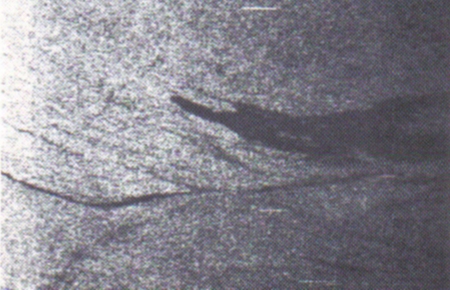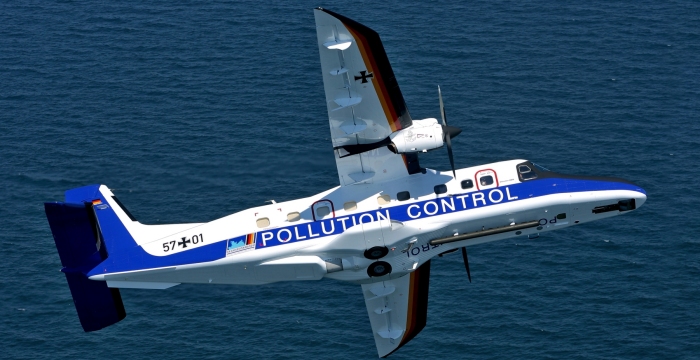Airborne Oil Pollution Patrol 2:
Long-range Oil Spill Detection with Radar
Scenario
With good luck, the pilot of a surveillance aircraft might find an oil spill along the flight track. But more often, this is not the case! Therefore, a sensor suitable to detect oil spills over long distances is needed. This sensor is the radar, i.e., the so-called Side-looking Airborne Radar or SLAR.
With its bar-shaped antenna fastened to the bottom side of the aircraft - as seen in the image below - the SLAR emits short microwave pulses which are directed to the water surface. Water is a good reflector of microwaves. Now, waves on the water surface make it possible that part of the radar pulses are reflected back to the aircraft and detected with the SLAR antenna. Oil on the water surface dampens waves, so that a flat water surface reflects the pulses away from the aircraft, just like a mirror, and reflected radar pulses are not detected with the antenna.
|
A maritime surveillance aircraft with the long bar-shaped SLAR antenna fastened below the aircraft. Source: Central Command for Maritime Emergencies, Cuxhaven, Germany |
We are operators of oil spill detection instruments, underway aboard a surveillance aircraft and we have a close look at the image obtained with the SLAR on the screen of the mission computer. At once we observe the image below:
|
Image of the sea surface to the right of the aircraft, taken with the Side-looking Airborne Radar (SLAR). The aircraft track is parallel to the left edge of the image. Image dimensions on the sea surface are approx. 3000 m along-track, 4000 m across-track. Source: The Archimedes 2 Experiment, Joint Research Centre, Ispra Establishment. |

|
How can we interpret the image above? Waves on the water surface yield echoes of the radar pulses, and the brightness of the white spots corresponds to the echo intensity. Areas having a flat water surface do not cause any radar echo and are thus shown in black colour.
Questions
- How do you interpret the black and white areas in the SLAR image? Where would you expect to find an oil slick
in the image?
- Can you identify spill areas with thin or thick oil film thickness?
- What are the advantages and limitations of SLAR for oil spill detection?
- Can you recommend SLAR
a) for long-range detection of oil pollution at sea?
b) to distinguish thin oil films caused by controlled spillages from larger oil volumes caused by accidental discharges?
Materials
- Student version of this worksheet: Long-range oil spill detection with radar, as html page or as printable rtf file
- Oil pollution and the fate of oil at sea
- Airborne maritime oil spill surveillance
- The Side-looking Airborne Radar
Time needed
- Two school lessons and/or one exercise for homework
Suggestions for procedure
- First lesson in class: Get together in groups of no more than five students and
- discuss the questions about the physical characteristics of oils and their behaviour on the water surface,
- decide which background information you may need to solve the problem, and
- assign a task to each member of your group which should be resolved by the time of the next lesson in school.
This should enable you to solve the given problem and present the results to your class.
Please note: not all the backgound information offered to you is needed to solve the problem! It's up to you to decide which information you may need.
- Homework: Resolve the task that has been assigned to you by your group.
- Second lesson in class:
- present what you have learned to your group
- discuss how your findings can help you to answer question 4, i.e. the choice of best instruments and methods for a given scenario
- present your results to your class using the information found in your enquiries.
Background Information
- Grüner K, R Reuter & H Smid: A new sensor system for airborne measurements of maritime pollution and of hydrographic parameters. GeoJournal, 24(1), 103-107, 1991. (5.8 MB pdf file)
- Tutorial: Fundamentals of Remote Sensing, Microwave Remote Sensing. Natural Resources Canada
- Thierry Toutin & Corinna Vester: Tutorial: Radar and Stereoscopy. Natural Resources Canada
- Werner Alpers, Leonid Mitnik, Lim Hock & Kun Shan Chen: Oil Pollution measured with ERS-SAR. Institut für Meereskunde, Universität Hamburg

